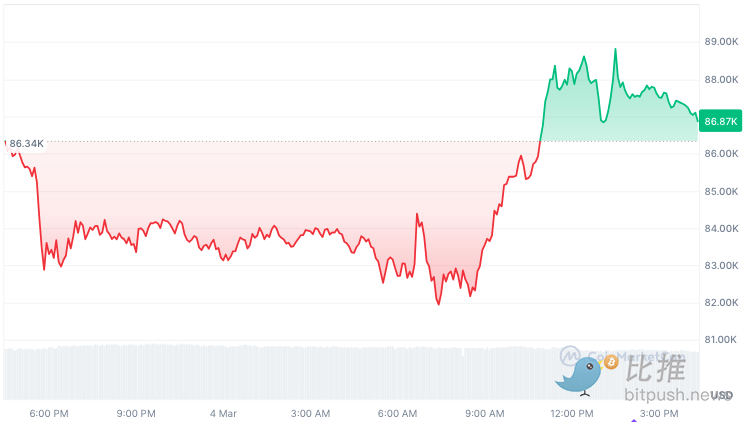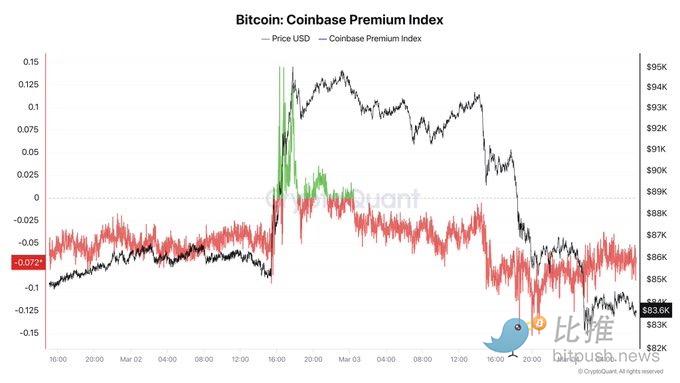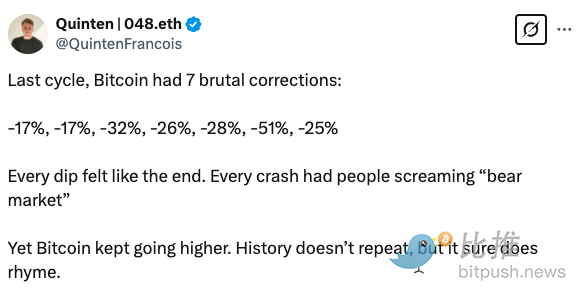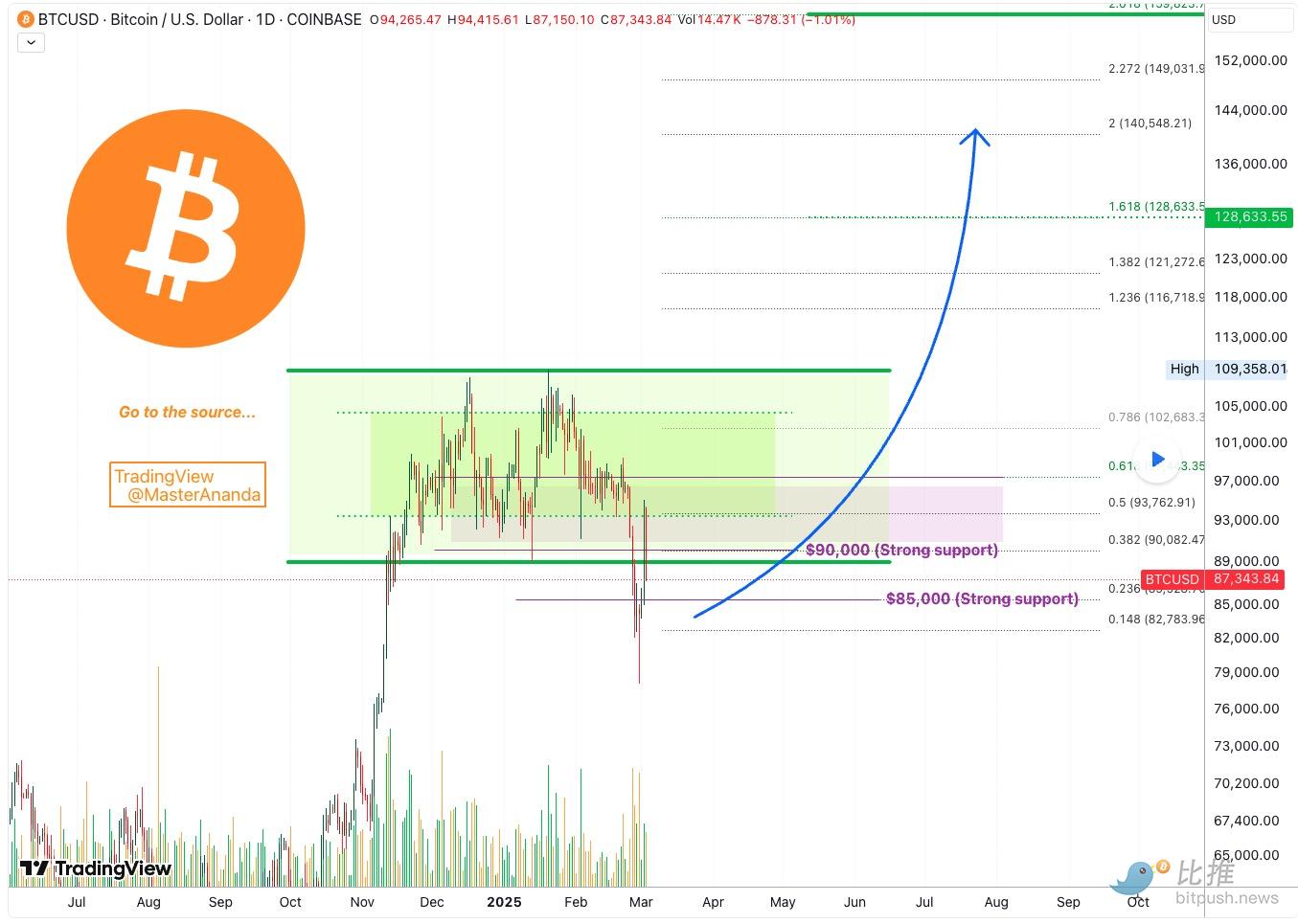Author: BitpushNews Mary Liu
After experiencing several days of turbulent volatility, risk assets saw a reversal overnight.
BitpushNews data shows that in the past 24 hours, Bitcoin (BTC) rebounded from the day's low of $81,500 to over $88,000, a gain of nearly 10% intraday. Meanwhile, the three major stock indexes narrowed their declines, with the Nasdaq closing down only 0.35%.

The "tug-of-war" between market sentiment and macroeconomic conditions
The recent market action has been sluggish, with Bitcoin rebounding from the $78,000 low on February 21 to $95,000, before retreating back to around $81,000, as the bulls and bears tug-of-war, leaving the market direction unclear. Although Trump's "pro-crypto" stance temporarily boosted market confidence, its impact was ultimately short-lived and failed to reverse the overall market weakness, with potential macroeconomic risks still hanging over the market like the "Sword of Damocles".
Ki Young Ju, CEO of CryptoQuant, believes that the Bitcoin market may continue to linger in a depressed state until there is a substantial improvement in the US market sentiment. Amid the uncertainty of regulatory policies, the complex and volatile macroeconomic environment, and the continued fluctuations in investor sentiment, whether Bitcoin can maintain its high-level performance in the long run remains uncertain. Before stronger market catalysts emerge, Bitcoin may continue to fluctuate within a wide range, and investors need to closely monitor market trends and capture key signals.

After losing the $90,000 level, the bulls face a severe challenge
Although the market has attempted to rebound multiple times, Bitcoin and the entire cryptocurrency market remain under pressure and have failed to establish a sustained upward trend. Many analysts have issued warnings that if the bulls want to reverse the downtrend, they must act quickly to regain key positions, or Bitcoin may face further downside risks.
However, Ki Young Ju believes that it may be too early to declare the end of the bull market cycle. CryptoQuant's on-chain data shows that market on-chain activity remains relatively subdued, and key indicators are neutral, indicating that although the market has performed weakly recently, the overall bull market pattern may not have been disrupted. Furthermore, the fundamentals of Bitcoin remain solid, with more mining machines continuously coming online, reflecting the confidence of the market's major participants in Bitcoin's long-term prospects.
Ju further pointed out that if this bull market cycle were to end now, it would likely not be the desired outcome for the major stakeholders, including early "whale" investors, large mining companies, traditional financial institutions, and US President Trump, who have publicly supported cryptocurrencies. Retail investors are usually considered the late entrants in a bull market cycle, and their market behavior may not be sufficient to dominate the market direction at this stage.
$85,000 becomes a critical liquidity test, will history repeat itself?
TradingView analysts believe that the key short-term support for BTC remains at $85,000, a level that has played a crucial role in the market tug-of-war in recent weeks.
If Bitcoin continues to trade below $85,000 in the coming days, it may trigger a larger-scale market sell-off, with the concentrated release of selling pressure potentially leading to an accelerated price decline and further confirming the bearish sentiment, at which point Bitcoin may face the risk of testing even lower support levels.
Quinten posted on the X platform, stating: Looking back at history may provide some insights. In the previous bull market cycle, Bitcoin experienced seven significant corrections, with declines of -17%, -17%, -32%, -26%, -28%, -51%, and -25% respectively. Each correction triggered market panic, making people feel that the "bear market" had arrived, and whenever the price plummeted, the narrative of "Bitcoin is dead" would circulate. However, history has proven that Bitcoin ultimately broke through the resistance and continued to rise. While history may not repeat exactly, it often remarkably rhymes.

In summary, the $85,000 and $90,000 price levels will become the focus of the short-term tug-of-war between the bulls and bears, and investors need to closely monitor the performance at these two key levels to gauge the market's next direction.

According to analyst MasterAnanda, the current market trend is quite "interesting" and is sending some key signals worth noting:
The bottom may have been reached: Last week, Bitcoin plummeted 28% from the $109,000 all-time high to a low of $78,300, before quickly rebounding strongly. This "V-shaped" reversal pattern is often seen as a signal of a cyclical market bottom, suggesting the likelihood of a further significant decline in the short term has decreased.
A healthy correction in a bull market: After a strong bull market rally, a certain degree of correction in the market is a normal phenomenon. This correction helps to release the accumulated profit-taking pressure in the market and accumulate new upward momentum, and a healthy adjustment can lay the foundation for a longer-term bull market.
A "golden opportunity" to buy the dip: The current market correction has actually provided a rare opportunity for off-market capital to enter the market. If you missed the previous Bitcoin rally from $85,000 to $95,000, now may be a relatively low-level entry point. The market always has opportunities, and the correction is an important "accumulation phase" in the bull market cycle.
The long-term bull trend remains intact: The long-term upward growth trend of Bitcoin has not fundamentally changed. Based on historical patterns, Bitcoin is expected to regain its upward momentum in the coming months and gradually move higher, and according to previous analyst forecasts, Bitcoin still has the potential to reach the $120,000 target price level next month.
Technical indicators provide support: Observing the Bitcoin daily chart, the 200-day moving average (MA200) is playing a key support role, and the MA200 has long been seen as one of the most important technical indicators for judging the long-term trend of cryptocurrencies. The current Bitcoin price trend is forming higher lows, suggesting that the bullish trend may be further confirmed.
Market sentiment and capital accumulation: This cycle is not solely driven by US government policies or geopolitical events, but also reflects the cyclical patterns of the market itself. Bitcoin has prepared for a new round of growth phase, and is expected to set new highs again in 2025. Additionally, there is still a large amount of capital waiting on the sidelines, and once the market stabilizes and rebounds, these funds are likely to accelerate their entry, further driving the market upward.
In summary, Bitcoin may have reached a cyclical bottom, and the market is entering a "consolidation phase" of volatility and accumulation. Although short-term market fluctuations are inevitable, the long-term bull trend remains solid. Investors can seize the current correction opportunity to gradually build positions at relatively low levels, be patient, and wait for the market to ultimately choose its direction.






